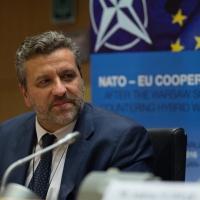A public Science|Business Network event (14:00 – 17:30 CET)
Within the space of a few short weeks, the actions of the second Trump administration have shaken the foundations of Europe’s post-Cold War security framework, and have forced political leaders everywhere to confront a new definition of “realpolitik” in the 21st century. Given the White House’s approach to resolving conflicts in Ukraine and the Middle East, deploying trade tariffs against even its largest partners and allies, and withdrawing from key multilateral institutions and agreements, the EU finds itself at arguably the most significant crossroads in its history, and under enormous pressure to define the direction and purpose of its next steps.
As highlighted in a major report in late 2024 by former Finnish president Sauli Niinistö, preparing for a multitude of cross-border threats and crises will imply an unprecedented 360-degree approach, bridging military and civilian domains while encompassing all pillars of government and society. Yet as Niinistö underlines, Europe can no longer afford endless debates about protocols and procedures – the severity of recent developments calls for urgent action and an immediate embedding of “preparedness-by-design” principles throughout key EU policies, instruments and programmes.
Building on Niinistö’s recommendations, the ReArm Europe Plan and the recent White Paper for European Defence – Readiness 2030 outline EU-wide steps and financial means to close critical capability gaps and build a strong defence industrial base, addressing both the short-term urgency of supporting Ukraine, but also the pressing long-term need to boost Europe's security and defence. In parallel, the European Investment Bank is gearing up to become a major investor in defence and security industries, and the European Innovation Council has just been given the green light to support companies developing dual-use technologies.
The worlds of industry and research have a pivotal role to play in shaping this new paradigm – as producers and suppliers of essential goods, as operators of critical infrastructure and services, and as developers of innovations, solutions and capabilities needed to tackle different threats. Each domain – from semiconductors, energy, transport and space to food, water and health – brings its own unique set of risks and complexities across the value chain, including access to materials, production capacity and stockpiling. And beyond the physical threats and challenges lie the digital equivalents, including cyber attacks on key infrastructures and institutions, data and IP theft.
Against this backdrop, several key questions arise: What will define “secure” in Europe’s most important sectors in the short and medium term? How can science and technology help the EU and its member states achieve that goal? How will ReArm Europe/Readiness 2030 translate in terms of research and innovation priorities and funding? From an implementation standpoint, how will the European Defence Fund and other instruments evolve? Looking at specific sectors, can the EU readiness and preparedness strategy provide a one-size-fits-all roof to address industry-specific security challenges? Finally, what are the critical actions needed to ensure the security of Europe’s R&I ecosystem itself?
On June 12, Science|Business will convene members of its international Network, EU institutions and other key stakeholders from research, industry and governments to discuss these issues and more in a high-level public event.












13:30 REGISTRATION AND COFFEE
14:00 WELCOME & OPENING REMARKS
- Maryline Fiaschi, Chief Executive Officer, Science|Business
14:05 Resilient network: What are the innovations needed to protect Europe’s critical infrastructures?
This session will bring together various perspectives and evaluate the importance of building a European technology innovation ecosystem to protect networks that a wide range of industrial sectors rely on. What are the resources and expertise required to ensure that energy plants, transport infrastructures and hospitals are equipped against physical, digital and hybrid threats?
A panel discussion featuring:
- Irina Kupiainen, Director, EU Affairs, Policy and Business Development, CSC-IT Center for Science
- David Luengo Riesco, Head of Brussels Office, Indra Group
- Nikolas Ott, Director, Cybersecurity and Defence Policy, Microsoft
- Martin Übelhör, Deputy Head of Unit, Innovation and Security Research, DG HOME, European Commission
Sponsored by Indra
15:00 Defence leap: Is Europe ready to invest in dual-use research and technologies?
Ambitions to maximise spillover effects between civilian and defence industries have been spelt out loud and clear in several communications by the European Commission, and funding opportunities have started materialising. However, are the EU and member states ready to deploy the means of their ambitions? Is the research community ready to embark on this dual-use journey? What does this policy gear change mean for multinationals operating internationally in fields like AI, quantum, semiconductors, etc?
An opening Q&A with: Robert de Groot, Vice-President, European Investment Bank
Followed by a panel discussion featuring:
- Manuel Aleixo, Cabinet Expert, Cabinet of Commissioner Zaharieva, European Commission
- Ethan Corbin, Director, Defence and Security Committee, NATO Parliamentary Assembly
- Robert de Groot, Vice-President, European Investment Bank
- Verena Fennemann, Head, EU Office Brussels, Fraunhofer
15:50 COFFEE BREAK
16:20 Live Q&A with: Sergii Nazarenko, Head, Office for Identification and Countering Threats to Critical Infrastructure Objects, NPC Ukrenergo
16:40 Heavens above: The role of space innovation for defence and security
This session will showcase the role of space in delivering the EU’s defence, security and preparedness strategy. Why is it essential for Europe to protect its space assets? What is the potential role of IRIS² in securing Europe’s communication infrastructures but also contributing to surveillance and crisis management? What technologies should Europe invest in as a priority?
A panel discussion featuring:
- Marco Brancati, Senior Vice President of Technology, Innovation & Systems Architecture - Space Division, Leonardo
- Kate Robson-Brown, Vice-President for Research, Innovation and Impact, University College Dublin
- Francesco Topputo, Full Professor of Space Systems, Politecnico di Milano
- Stijn Vermoote, Head of User Outreach and Engagement, European Centre for Medium-Range Weather Forecasts
17:25 CLOSING REMARKS
17:30 Networking reception
For further information, please contact [email protected]
Venue:
Maison de la Poste (Tour & Taxis)
Rue Picard 7, 1000 Bruxelles



 A unique international forum for public research organisations and companies to connect their external engagement with strategic interests around their R&D system.
A unique international forum for public research organisations and companies to connect their external engagement with strategic interests around their R&D system.